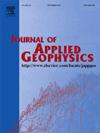利用高斯-牛顿法反演二维无线电大地电磁资料
IF 2.2
3区 地球科学
Q2 GEOSCIENCES, MULTIDISCIPLINARY
引用次数: 0
摘要
提出了一种基于高斯-牛顿优化的无线电大地电磁(RMT)地基和机载数据二维反演算法。基于非结构网格的RMT正演建模采用了有限元法。反演了包括视电阻率、相位和倾斜角在内的综合模型的地基响应,并评价了倾斜角的横向分辨率。然后评价了观测高度、地形和噪声水平对机载RMT自卸车响应和反演模型的影响。最后,进行了地面数据与机载自卸车的同步反演。综合算例表明,倾斜资料反演能更清晰地识别地质构造的横向电阻率变化。随着观测高度的增加,由目标结构引起的机载倾斜度有效值随观测高度的增加而减小。地形对飞机倾卸的影响是不可忽视的,通过考虑地形的反演可以消除这种影响。当可以获得足够的机载倾卸数据时,需要测量少量的地面阻抗数据来获得电阻率值。密集的机载倾卸与稀疏的地面阻抗测量相结合的策略,提高了勘探效率,并保持了电阻率成像的高可靠性。本文章由计算机程序翻译,如有差异,请以英文原文为准。
Inversion of airborne tipper and ground-based data for two-dimensional radio-magnetotelluric using the Gauss-Newton method
A two-dimensional inversion algorithm based on the Gauss-Newton optimization has been developed for both ground-based and airborne data of Radio-magnetotelluric (RMT). The Finite Element Method (FEM) has been used in the forward modelling of RMT based on the unstructured mesh. The ground-based responses of a synthetic model including apparent resistivity, phase and tipper have been inverted and the lateral resolution of tipper has been evaluated. Then the effect of observed altitude, topography, and noise level on the airborne RMT tipper response and inverted model has been evaluated. Finally, the simultaneous inversion of ground-based data and airborne tipper has been carried out. The synthetic examples indicate that the inversion incorporating tipper data can more distinctly identify lateral resistivity variation in geological structures. The available anomaly included in the airborne tipper caused by the target structure diminishes as observed altitude increases. And the effect of topography on airborne tipper cannot be ignored, which can be eliminated by inversion with topographic consideration. When adequate airborne tipper data can be acquired, a small number of ground-based impedance data is need to be measured for obtaining resistivity values. The combined strategy of dense airborne tipper with sparse ground-based impedance measurement makes the exploration more effective and keeps great reliability for electrical resistivity imaging.
求助全文
通过发布文献求助,成功后即可免费获取论文全文。
去求助
来源期刊

Journal of Applied Geophysics
地学-地球科学综合
CiteScore
3.60
自引率
10.00%
发文量
274
审稿时长
4 months
期刊介绍:
The Journal of Applied Geophysics with its key objective of responding to pertinent and timely needs, places particular emphasis on methodological developments and innovative applications of geophysical techniques for addressing environmental, engineering, and hydrological problems. Related topical research in exploration geophysics and in soil and rock physics is also covered by the Journal of Applied Geophysics.
 求助内容:
求助内容: 应助结果提醒方式:
应助结果提醒方式:


